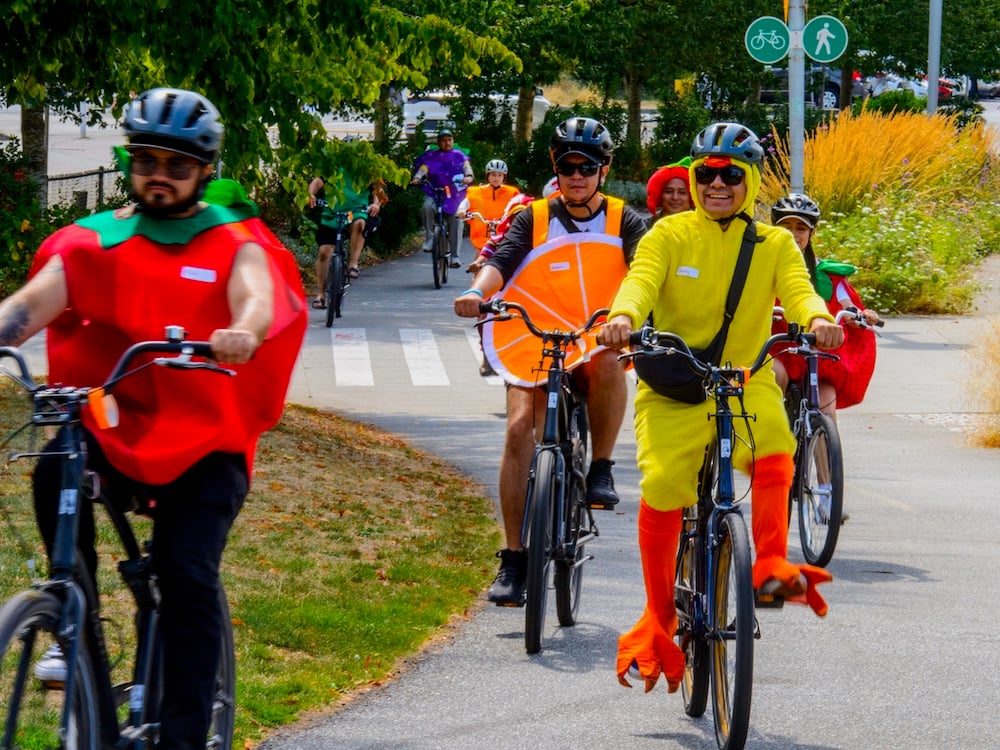
Isaac Phan Nay Today The Tyee Isaac Phan Nay is The Tyee’s labour reporter. This reporting beat is made possible by the Local Journalism Initiative . URL copied to clipboard! SHARE: 68 SHARES Luz Rosas and Carlos Colín want British Columbians to see a different side of temporary foreign workers.
The number of migrant workers in B.C. has ballooned in recent years, as thousands of temporary foreign workers come from Mexico, Guatemala, Jamaica and other countries to work in farms, orchards and vineyards across the province annually.

But new federal policies that would see Canada accept fewer foreign workers highlights how they are seen as “invisible and disposable,” Rosas said. “People think migrant workers are there to pick food, like a machine,” she said. “But they are a person who exists in this world and is unique.
” Luz Rosas, left, and Carlos Colín, right, are behind Invisibles y Desechables , a photo exhibit at Place des Arts in Coquitlam. Photo for The Tyee by Isaac Phan Nay. Rosas, a photographer who initially came from Mexico City to work as a tree planter in northern B.
C., has been taking pictures of migrant farmworkers since 2011 and is helping Dignidad Migrante Society create an archive of photographs documenting migrant farmworkers’ life off the fields. Colín, a Vancouver-based artist who moved from Mexico City to study at the University of British Columbia, curated the portraits into an exhibit he hopes challenges perceptions of migrant workers.
The exhibit Invisibles y Desechables — Spanish for “invisible and disposable” — debuted at Place des Arts in Coquitlam last week. Rosas and Colín joined The Tyee in a noisy East Vancouver café to share more insight on shifting attitudes toward migrant workers. The conversation has been edited for length and clarity.
The Tyee: Why did you start taking farmworkers’ portraits? Luz Rosas: It started with curiosity. As a photographer, I am always on the watch for things that interest me and a lot of things that interest me are in the community where I live. I met Raul Gatica with what is now Dignidad Migrante Society.
He was working with temporary farmworkers in Abbotsford. I started to follow what they do and volunteered. Then I started to hop around in my car, going to farms and meeting some people here and there.
For the first photos I took, I drove around the fields, trying to take pictures of the farm from far away. Slowly, by constantly going over and over again, I started to meet people. I was going three months every year, different times of the month, or wherever I had the time to go.
When I started to visit the workers themselves, in the places where they were living and where they were hanging out, I started to snap shots. Just asking, “Can I take your portrait?” It became just portraits of them in their space, not working in the field, like picking berries, just a regular portrait of a person. Photo by Luz Rosas.
What inspired you to work on this exhibit? Carlos Colín: I came to study and get a master’s degree at the University of British Columbia after living in Mexico City for 30 years, and my intention was just to study and go back to Mexico City. My experience with the workers started on planes flying between Vancouver and Mexico City, back and forth during holidays. I started noticing that most of the people on the planes were farmworkers.
RELATED STORIES For the Aunties, with Love ‘Without Them, We’re not Farming’ I started talking with them one-on-one while sitting in the same row, and listening to their experiences. They looked tired. That’s one of the things that I always have in my mind when I have these conversations.
It’s hard to move every year, far from your land, from your family. Luz Rosas, you’ve been photographing migrant workers for more than a decade. How have they changed? Rosas: One of the changes that I noticed is that there are more women around than before.
Lots of women are coming to try to live here with their families. The workers are also becoming more and more aware about their rights, at least the ones that hang around where we are. They communicate between each other and pass on information, like how to get a medical card.
People are standing up for themselves. They’re just not willing to take mistreatment anymore, because they can see that it’s worse not to do anything. Photo by Luz Rosas.
How do you feel the government’s attitude has changed toward migrant workers? For the Aunties, with Love read more Rosas: It hasn’t really. I hear a lot of things on the radio, and lately I just hear that they blame them for housing and employment issues, but I don’t see real change on the part of the government. What about new reduced immigration and foreign worker levels? Rosas: I meet a lot of undocumented workers in Vancouver.
I meet them while I’m walking around on the street and talk to them, because I speak Spanish. They tell me they came here to do construction work, mostly. When I came to Canada a long time ago, as a tree planter, you could not just work without papers, but now, it’s like everybody does.
This government knows there are many thousands of people here without permission. It knows they’re here because the government allows them to come, in a kind of “I can put a blind eye to this” way. Photo by Luz Rosas.
How are you hoping to challenge Canadian views on migrant workers? ‘Without Them, We’re not Farming’ read more Rosas: I think it’s very important to be acknowledged by others. These workers, they sacrifice a lot of things. They have family, they have cars, they have the same dreams and problems that we all have.
So I think it's important to acknowledge all these people individually. Colín: Sometimes people view migrant workers through this misery porn sphere. They always expect that the workers suffer.
I don’t want to show them suffering or in shitty conditions; I think it’s a good idea to show them in a different way: in leisure, laughing. If all you see is misery porn, you also tend to victimize these people, even if you don't want to. I believe that avoiding misery aesthetics helps people engage in a different way.
‘Invisibles y Desechables’ (Invisibles and Disposables): Temporary Foreign Workers’ Life and Rituals’ is on view at the Place des Arts in Coquitlam until March 13. Read more: Labour + Industry.











